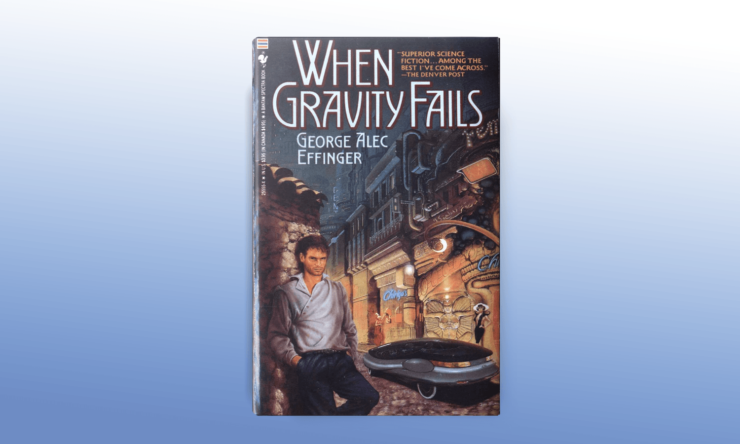George Alec Effinger’s When Gravity Fails is something of an overlooked classic in the cyberpunk canon: beloved by those who have read it, but rarely mentioned these days in the same breath as much better-loved novels like Neuromancer. It’s a shame that’s the case, since its mix of violent pulp, focus on a more terrestrial used-future setting, and dark, sardonic humor elevate it well above the usual somber city noir cyberpunk calls home. It’s also just begging for a full-series adaptation on a channel or platform that could do justice to the sprawling red-light districts and larger-than-life characters of the Budayeen.
The book offers something for practically everyone: the serial-murder investigation and the conspiracy behind it offer plenty of twists and turns for mystery fans; there’s a heaping helping of horror in discovering exactly how depraved the villains and setting actually are, plus some tense and absolutely brutal fight scenes and a very grim, deadpan sense of humor tying it all together. With its sprawling, diverse, and inclusive cast of characters, a setting that bucks the usual trend of American or East Asian-influenced cities, deep attention to nuance and detail, and offbeat take on classical detective-novel tropes, the right writers’ room and a decent budget could make When Gravity Fails into an instant classic.
So, what’s it about? In an unnamed Middle Eastern city of the future lies the Budayeen, a sprawling maze of slums and red light districts which Effinger based on the French Quarter of New Orleans. In this section of the city, violence is casual, life is cheap, cops are mostly crooked, and the local cabbie is an American ex-pat with a cybernetic lung full of military grade LSD. Our guide to this twisted urban wonderland is Marîd Audran, a part-time troubleshooter, PI, and all-around hustler who will take any job if it feeds his addictions, doesn’t involve a lot of danger, and keeps him independent. While he might not be loyal to anyone in particular, Marîd does have a code, which is probably why a rich client seeks him out for a case just before being gunned down midway through the pitch by a man who thinks he’s James Bond. Pressed into service by the Budayeen’s nigh-immortal crime lord Friedlander “Papa” Bey, Audran is forced to solve his client’s case while tracking down “James Bond”—actually a ruthless and unstoppable serial killer with bootleg personality chips of infamous murderers and assassins—before the body count gets too high.
With a plot like that, there’s built-in action and suspense aplenty and enough hooks for any creator to sink their teeth into, but more than that, the level of detail leaps off the page. Effinger’s prose is awash in vivid descriptions and atmosphere, from the beginning in Chiriga’s bar where the first murder takes place all the way to the shadowy room where the plot finally unravels, all of it deeply (and sometimes uncomfortably) vivid. You’re immediately drawn into the evocative atmosphere, sensing at every turn that this is a lived-in setting, where the technology always seems vaguely busted, and murder is so common that the first page of the book mentions “a very convenient cemetery.” It really adds to the cinematic feel of the book, and with the right art direction and camera-work, it would be amazing to see all this potential realized onscreen. Especially since modern genre shows sometimes struggle to capture a genuinely unique feel and sense of place, two things When Gravity Fails manages to achieve with flying colors.
It’s also remarkably down-to-earth for a cyberpunk setting. There isn’t much in the way of “cyberspace” in the Budayeen, with cybernetics mainly limited to body modification and a neural implant that allows people to modify their personalities or slot in temporary skill chips. It makes for a much grittier world, one without the ephemeral layer that usually accompanies stories about hacking, cyberspace, and more networked worlds. Characters call each other on the phone, what enhancements there are tend to focus on modifying physical characteristics or neurology, and while there might be flying cars or flashy internet or VR paradises in the wider city, no one’s seeing any of it in the Budayeen. It gives the world its own feel, but it also makes a potential adaptation a lot more economical—there’s a level of tech, to be sure, but it’s a lot less showy and would require far fewer expensive effects than other cyberpunk settings.
What makes When Gravity Fails unique is that the world and the plot are defined more by character interactions and reactions than any exposition. Audran is introduced as a small-time player who is glad to have that position—he values his own agency and protects it by staunchly turning down complicated jobs, avoiding situations that “aren’t his problem,” and refusing any cybernetic enhancements. The action kicks off as he makes a series of quick moves that introduce you to his friends, associates, and enemies. As the plot strips away the layers of his moral code and sense of agency, forcing him to spend every favor and burn every bridge he has in an attempt to catch the killer and avoid being killed by either Bey or Bond, it sends him pinballing wildly into friends and enemies alike, further fleshing out the Budayeen and his place in it. It also means that each sacrifice Audran is forced to make has more emotional weight, as people he’s interacted with for most of the story abandon him and his struggle against the various powers manipulating him becomes more desperate. It’s what makes the book so perfect as a potential TV series—a plot that expands and fleshes things out with each successive twist, where the majority of the action unfolds on-screen and brings a succession of gripping character moments to the fore, making each interaction in an episode feel increasingly more meaningful and compelling.
Which brings us to the cast. First, since the novel is one of the several cyberpunk books from the ’80s that actually acknowledges the existence of people who aren’t cis, het, and white, the motley assortment of movers, shakers, hustlers, and businesspeople of the Budayeen represent an opportunity to bring an incredibly inclusive collection of performers to the screen. Almost the entire cast is Middle Eastern or North African and Muslim (as fits the setting), with some notable exceptions being Black and Asian. A couple of prominent characters are also trans and queer, with gender nonconforming appearances being kind of the societal norm. And beyond having a large, compelling, and inclusive cast, Effinger was inspired by classic noir, resulting in an entire host of colorful friends, enemies, and suspects who have their own backstories, favorite dives and hangouts, and entire lives that exist outside of Audran’s influence or perspective.
Buy the Book


The City Inside
Characters in When Gravity Fails tend to have a unique aesthetic, too, whether it’s the performative touches that people like the Black Widow Sisters (a trio of trans goth assassins) add to make them stand out, the understated opulence of Bey’s mansion, the overly pious front the local debt collector puts on, or even the run-down and nondescript style Audran himself tends to favor. Effinger goes deep, detailing the way someone’s posture or voice or the banter they have with Audran adds something to their character. In the right hands, most of the characters could really come to life on screen, and even immensely benefit from having a more expansive, episodic format that gives them room to grow.
One caveat is needed, however: Despite its inclusivity and willingness to develop characters outside the cis, het, and white experience, When Gravity Fails was written in 1986 by someone who was obviously unequipped to talk about…well, any of that, really, in terms of lived or firsthand experience. Three trans characters (at the least) are brutally murdered over the course of the novel, Audran’s got some bizarre prejudices including examining trans women’s hands, and there’s a weird streak of transmedicalism going on with the body-modification, in that it assumes that trans people would automatically want to pursue gender confirmation procedures. And that’s even before we get into Chiriga, the Black nightclub owner who files her teeth down so she can look more intimidating (other than her look, she’s absolutely amazing, but oof) . It’s…a lot. An adaptation, bringing fresh perspectives to these characters and stories, has the opportunity to succeed where the book failed. That isn’t to say that marginalized people should be forced to correct for the failings of the past, but for creatives interesting in adapting an older work, there are almost always going to be problematic pitfalls and failures of representation to take into account. That’s part of the beauty of adaptation—the chance to take the work beyond the boundaries of the text and make it something bigger, more expansive, and more inclusive than the original work. The bones of a truly captivating cyberpunk story filled with strong, fascinating characters are already there, waiting for someone with a modern eye to present them to a new audience. An adaptation that embraces and values the input of a diverse array of voices in the writers’ room and other aspects of production will only help to achieve the inclusive vision the book was aiming for by addressing the places where it fell short.
And in the end, the opportunity to rectify these flaws might be the best reason to give When Gravity Fails the adaptation it deserves—one which celebrates everything the book gets right, from its incredibly vivid world, extensive cast of amazing characters, and the writing that manages to make every space and visual feel camera-ready. The Budayeen has so much to offer genre fans of every stripe, and with a dedicated writing and creative team behind it, it could finally escape the cyberpunk shadows and take its place in the sun.
Sam Reader is a literary critic and book reviewer currently haunting the northeast United States. They mainly contribute at Tor Nightfire, but their writing can be found at The Barnes and Noble Science Fiction and Fantasy Book Blog (RIP), Tor.com, and their personal site, strangelibrary.com. In their spare time, they drink way too much coffee, hoard secondhand books, and try not to upset people too much.










